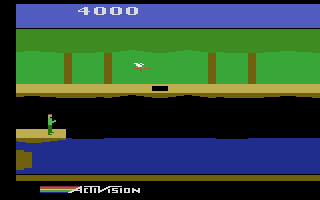Have no fear, we’ve not forgotten about Arcade Mermaid, our regular classic arcade feature. I don’t think this post is quite the right material for it, but it’s still very interesting.
People who played the Atari VCS, later renamed the Atari 2600, will no doubt remember David Crane’s seminal Pitfall!, one of the greatest, and certainly one of the best-selling, games for the system.
Pitfall’s huge success spurred the creation of a sequel, Pitfall II: Lost Caverns, which is certainly among the most technically brilliant games for the VCS. We recently covered how one of its best tricks was how it managed to get music out of the Atari’s TIA chip that few other games were capable of. That’s not all it did. Pitfall! was one of the very first exploratory platformers, and Pitfall II expanded its focus greatly. Some might call it the first Metroidvania, although it doesn’t have the item-based progression gating usually associated with that genre.
It does have great design ingenuity though. It gets its challenge not through limited lives but its huge and complex system of caverns. In fact, it abandons lives entirely, replacing them with a checkpoint system, another possible first. Getting “killed” never ends the game, instead, it just costs points and returns the player’s surrogate Pitfall Harry to the last cross he touched. So anyone, given enough time and effort, can finish the game; they might not have a good score when they do it though, which still leaves room for players to improve.
Pitfall II, with its huge world and great music on a system not known to be able to support either, powered by a custom microchip that Crane himself designed, called the DPC, would undoubtedly have been a giant hit if it had been released a year before. Sadly, it came out right at the end of the VCS/2600’s life. Crane had hopes that the DPC would help revive the system but, sadly, it became the only game to utilize it.
But that wasn’t the end of Pitfall II. While it was designed around the limitations of the VCS, it received ports for several other systems, including the Apple II, the Atari 5200 and Atari’s 8-bit computers (which both had a secret second world to explore after finishing the first!), the Commodore 64 of course, Colecovision, MSX, SG-1000 and ZX Spectrum. It even got a kind of NES port, called Super Pitfall, which was programmed by anonymous NES contractor Micronics and is widely regarded as terrible. And then, there was the arcade version.
Sega’s arcade version of Pitfall II is more of a recreation than a port! It’s divided into levels and goes back to the standard arcade paradigm of limited lives. Its first level resembles a condensed version of the first game, with some extra hazards built it. The game world is both smaller and harder than the original, to make it harder to master and thus entice players to put in more money. You can see for yourself in the below playthrough, a deathless run up on the Replay Burners channel. Videos on Replay Burners are done cheatless and without tool-assist, so you can be assured that an actual player performed this run and not a control script. The video is about 27 minutes long.

